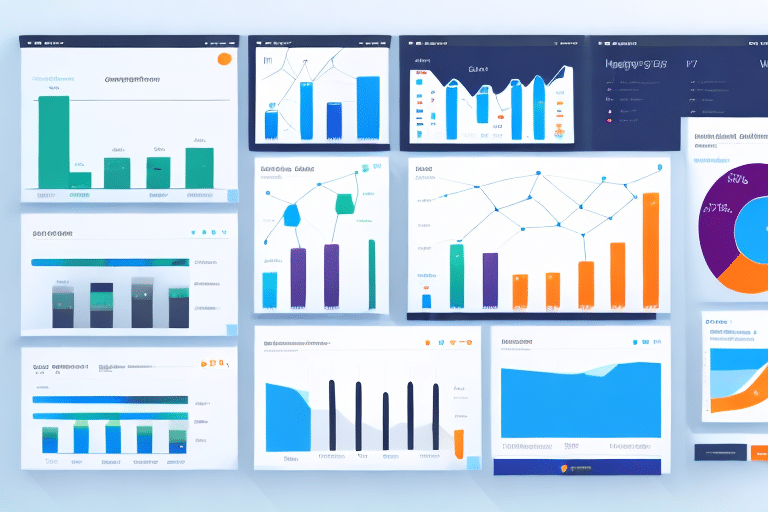Measuring Your Conversion Rate: The Key to E-Commerce Success
As an e-commerce business owner, your primary goal is to generate revenue from the traffic that visits your website. However, driving traffic to your website is only half the battle. You also need to ensure that your visitors are converting into paying customers. This is where measuring your website's conversion rate comes into play and why it matters for the success of your e-commerce operations.
Understanding Conversion Rate in E-Commerce
What is Conversion Rate and Why Does It Matter?
Conversion rate refers to the percentage of website visitors who take a desired action, such as making a purchase, filling out a form, or downloading an ebook. In simple terms, a high conversion rate means that more of your website visitors are taking the desired action that you want them to take.
Measuring your website's conversion rate is crucial because it provides insight into how well your website is performing and whether your marketing efforts are paying off. Additionally, a high conversion rate can result in increased revenues, improved customer acquisition costs, and a competitive advantage in your industry.
There are several factors that can impact your website's conversion rate, including the design and layout of your website, the quality of your content, the ease of navigation, and the overall user experience. By analyzing these factors and making necessary improvements, you can increase your conversion rate and ultimately drive more business success.
The Importance of Conversion Rate for E-Commerce Businesses
E-commerce businesses rely heavily on their website's conversion rate to generate revenue. A high conversion rate means that more of your website visitors are turning into paying customers, which can lead to increased profitability and long-term success.
On the other hand, a low conversion rate can indicate underlying issues with your website or marketing strategies that need to be addressed. By measuring your conversion rate and identifying areas for improvement, you can increase the likelihood of converting visitors into customers and ultimately, grow your business.
One way to improve your website's conversion rate is by optimizing your website's user experience. This includes ensuring your website is easy to navigate, has a clear call-to-action, and is visually appealing. By providing a positive user experience, visitors are more likely to trust your brand and make a purchase.
Another factor that can impact your conversion rate is the quality of your product descriptions and images. Providing detailed and accurate information about your products can help build trust with potential customers and increase the likelihood of a sale. Additionally, high-quality images can showcase your products in the best possible light and make them more appealing to potential buyers.
Calculating and Tracking Your Conversion Rate
How to Calculate Your Website's Conversion Rate
Calculating your website's conversion rate is a straightforward process. Simply divide the number of conversions by the total number of visitors to your website, and multiply the result by 100.
For example, if your website had 1,000 visitors and 50 of them made a purchase, your conversion rate would be 5% (50/1,000 x 100).
It's important to regularly monitor your website's conversion rate to track the effectiveness of your marketing efforts and website design. A low conversion rate may indicate that your website needs improvement, such as clearer calls-to-action or more compelling product descriptions. On the other hand, a high conversion rate may suggest that your website is performing well, but there may still be room for optimization to further increase conversions.
Utilizing Data Analytics to Track and Measure Your Conversion Rate
Using data analytics tools, such as Google Analytics, can help you track and measure your website's conversion rate and identify areas for improvement. Analytics tools can help you understand user behavior, track the success of your marketing campaigns, and make data-driven decisions to improve your website's performance.
Implementing A/B Testing to Improve Your E-Commerce Conversions
A/B testing is a powerful tool that can help you experiment with different marketing strategies and measure their impact on your website's conversion rate. A/B testing involves creating two versions of a webpage or marketing campaign and testing them against each other to see which one performs better.
By using A/B testing, you can identify successful strategies and make data-driven decisions to optimize your website and improve your conversion rate.
Best Practices to Improve Your Conversion Rate
Optimizing Your Website's Design and User Experience
- Ensure your website is easy to navigate and helps visitors find what they're looking for quickly.
- Use clear and compelling calls-to-action (CTAs) that guide visitors towards desired actions.
- Implement a responsive design to provide a seamless experience across all devices.
- Maintain a visually appealing layout with high-quality images and concise messaging.
Enhancing Product Descriptions and Visuals
- Provide detailed and accurate information about your products or services.
- Use high-resolution images and, if possible, videos to showcase your products effectively.
Building Trust with Customer Reviews and Ratings
Including customer reviews and ratings on your website can significantly impact your conversion rate. According to a study by BrightLocal, 91% of consumers read online reviews before making a purchase decision.
Encourage customers to leave reviews by offering incentives or sending follow-up emails after their purchase. Displaying these reviews prominently can help build trust and confidence with potential customers.
Offering Incentives and Streamlining Checkout
- Offer free shipping, discounts, or other incentives to encourage visitors to make a purchase.
- Implement a simple and streamlined checkout process that minimizes friction and makes it easy for customers to complete their purchase.
Personalizing the Shopping Experience
Providing personalized recommendations and product suggestions based on a customer's browsing and purchase history can help increase the likelihood of a sale. Utilizing data analytics and machine learning algorithms can help automate this process and offer a more tailored shopping experience.
Identifying and Avoiding Common Mistakes
Common Mistakes That Hinder E-Commerce Conversion Rates
- Complicated Checkout Process: A lengthy or complex checkout can lead to cart abandonment.
- Lack of Information: Not providing enough details about your products or services can deter potential customers.
- Non-Mobile Optimized: With increasing mobile usage, a non-responsive website can alienate a significant portion of your audience.
- Slow Load Times: Websites that take too long to load can frustrate users and lead to higher bounce rates.
- Unclear Messaging: Using confusing language or not clearly communicating your value proposition can reduce conversions.
Identifying Areas for Improvement in Your E-Commerce Funnel
Your website's conversion rate is impacted by several factors, including the design and functionality of your website, the user experience, and your marketing strategies. To identify areas for improvement, it's important to analyze each step in the e-commerce funnel, from the initial landing page to the checkout process.
Consider using analytic tools, like Google Analytics, to track user behavior and identify potential drop-off points in the funnel. By addressing these issues, you can improve the user experience and increase the likelihood of converting visitors into customers.
Another important factor to consider when identifying areas for improvement in your e-commerce funnel is the speed of your website. Slow loading times can lead to frustration and cause visitors to abandon their shopping carts. Make sure to optimize your website's images and code, and consider using a Content Delivery Network (CDN) to improve loading times. Additionally, ensure that your website is mobile-friendly, as more and more consumers are using their mobile devices to shop online.
The Impact of Mobile Optimization on Conversion Rates
Today, more and more consumers are using their mobile devices to browse and make purchases online. As a result, it's essential that your website is optimized for mobile devices to ensure a seamless user experience and maximize your conversion rate.
Some tips for mobile optimization include:
- Using a responsive design that adapts to different screen sizes.
- Optimizing your website's load times by compressing images and minimizing code.
- Simplifying the checkout process to make it quick and easy on mobile devices.
- Ensuring that buttons and links are easily tappable and accessible.
Building Customer Trust and Confidence
Strategies for Increasing Customer Trust
- Provide clear and detailed information about your products or services.
- Include customer reviews and ratings to build trust with potential customers.
- Offer a clear and simple return policy to address concerns about product quality.
- Display trust symbols, like security badges or certifications, to assure customers of your site's safety.
Implementing these strategies can help establish credibility and encourage visitors to take the desired actions on your website.
The Role of Customer Reviews in Influencing Conversion Rates
Customer reviews and ratings can have a significant impact on your website's conversion rate. According to a study by BrightLocal, 91% of consumers read online reviews before making a purchase decision.
By including customer reviews and ratings on your website, you can build trust and confidence with potential customers and increase the likelihood of converting visitors into customers. Encourage customers to leave reviews by offering incentives or sending follow-up emails after their purchase.
Enhancing User Experience for Higher Conversions
The Importance of User Experience
The user experience is a critical factor in driving higher conversion rates on your website. A smooth and seamless user experience can help visitors navigate your website, find what they're looking for, and ultimately, complete a purchase.
Consider using analytics tools to track user behavior and identify areas for improvement in the user experience. Additionally, keep the design of your website simple, clean, and easy to navigate to minimize friction and prevent visitors from getting frustrated or confused.
Optimizing Website Design to Boost Conversions
- Ensure your website is mobile-friendly and responsive for a seamless user experience on all devices.
- Use eye-catching and appealing visuals to showcase your products and services.
- Communicate your unique value proposition clearly and concisely to encourage visitors to take action.
- Implement a simple and streamlined checkout process that minimizes friction and makes it easy for customers to complete their purchase.
- Include trust symbols, like security badges or customer ratings, to build trust with potential customers.
Another important design element to consider when optimizing your website for conversions is the use of social proof. Social proof refers to the idea that people are more likely to take action if they see that others have already done so. Including customer reviews, testimonials, or case studies on your website can help build trust and credibility with potential customers, and encourage them to make a purchase or take another desired action.
The Financial Impact of Conversion Rates
The Impact of a High Conversion Rate on Your Bottom Line
A high conversion rate can have a significant impact on your bottom line. For example, if you have 10,000 website visitors and a conversion rate of 5%, that means you've converted 500 visitors into customers. If the average order value is $50, that equates to $25,000 in revenue. If you increase your conversion rate to 10%, that would result in 1,000 customers and $50,000 in revenue.
However, increasing your conversion rate is not just about increasing revenue. It can also lead to a better return on investment (ROI) for your marketing efforts. By converting more visitors into customers, you are essentially getting more value out of the money you spend on advertising and other marketing activities. This can help you to allocate your marketing budget more effectively and achieve better results overall.
Conclusion
Measuring your website's conversion rate is essential for the success of your e-commerce business. By understanding the factors that influence conversion rate and implementing best practices, you can increase your likelihood of converting visitors into customers, boost your revenue, and grow your business over time.




















